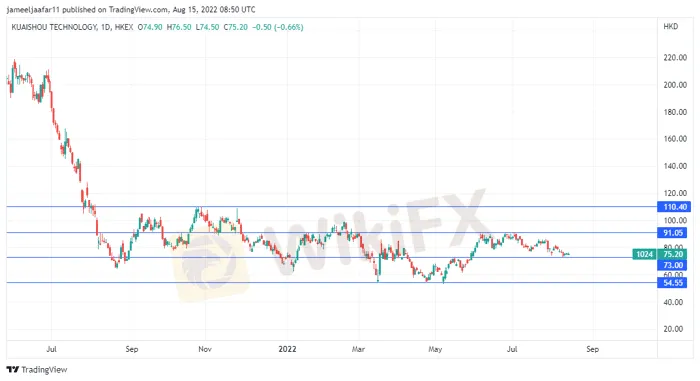简体中文
繁體中文
English
Pусский
日本語
ภาษาไทย
Tiếng Việt
Bahasa Indonesia
Español
हिन्दी
Filippiiniläinen
Français
Deutsch
Português
Türkçe
한국어
العربية
Kuaishou – Tagging Onto the Tail of TikTok
Abstract:Today, Kuaishou Technology is the world’s 419th most valuable company with a market capitalization exceeding $40 billion.

Have you heard about Kuaishou, the flourishing Chinese social platform? With over 320 million daily active users, Kuaishou‘s social media app, which centers around the growing trend of short-form videos, has established itself as China’s second-largest short video platform. In first place is none other than Douyin, the Chinese version of TikTok.
Founded in 2011 as “GIF Kuaishou”, the original vision was to enable the creation & sharing of animated images known as GIFs, which were the old-school form of short videos. The company then became Chinas first-mover in the short video industry, allowing users to create, view and upload short videos via mobile.
It launched this service in 2013, with its notable success opening many doors for Kuaishou. Its video-sharing app has not only flourished in China, but also the rest of the world. The app is among the most downloaded applications on Google Play & the Apple App Store in eight countries, including Indonesia, Pakistan and Taiwan.
Over the years, the Chinese tycoon endeavored in live streaming, commenced in e-commerce, tapped into digital marketing and even explored the gaming world. Today, Kuaishou Technology is the worlds 419th most valuable company with a market capitalization exceeding $40 billion.
The Business Model
Kuaishou makes money in a number of ways. Historically, its main moneymaker was the live-streaming business segment, which generates revenue off of users purchasing virtual goods which they gift to their favorite streamers.
The company also generates revenue from advertising, online marketing, e-commerce and gaming. As advertisers flock to Kuaishou to present their ads, Kuaishou benefits by running such ads on its popular platform. The company also enjoys a stake of in-game purchases and e-commerce transactions.
The $5 Billion IPO
Let‘s talk stocks. Kuaishou’s stock market debut on February 5th of last year wasnt humble; it was ferocious. On its launch in Hong Kong, its shares have ripped through the skies, nearly tripling in value. Kuaishou has raised a commendable $5.32 billion from the initial public offering, representing yet another triumph for the Hong Kong stock exchange.
After the IPO, things went downhill. Investors were swayed away from Chinese tech companies amid increasing regulatory scrutiny from lawmakers and watchdogs, which restricted the capabilities and freedom of technology firms. Alibaba, JD.com, Tencent and most Chinese giants have all become victims of a vicious 2021.
Recent Performance
In the latest fiscal quarter, Kuaishous financial results were nothing short of excellent:
Revenue: $3.12 million – up 24% year-over-year
Gross profit: $1.30 million – up 26% year-over-year
Average Daily Active Users (DAUs): 345.5 million – up 17% year-over-year
Average daily time spent per DAU: 128.1 minutes – up 29% year-over-year
For the period ended March 31st of 2022, online marketing services generated RMB 11.4 billion ($1.68 billion), which accounted for 54% of total revenue. Live streaming represented 37% of total revenue, and the remaining 9% stake was generated from other services.
Such magnificent quarterly figures have been reflected on user traffic, which has increased exponentially over the past year. Users are spending more time on the platform, and the number of active users are growing by the minute.
Technical View

As seen in the TradingView chart, the Kuaishou stock (HKG: 1024) has plunged in 2021 after its market debut, and isnt looking too attractive when putting on a long-term lens. The war on Ukraine exacerbated declines, with increasing COVID-19 lockdowns & restrictions in the Asian nation further-magnified investor aversion. However, Kuaishou remained robust and resisted the headwinds of 2022.
Its safe to say that the short-term trajectory is looking optimistic. Currently trading in the middle part of its yearly range with a price tag of HKD 75.20, the stock rests between the two supports level of HKD 73 and HKD 54, and the two resistance levels by HKD 91 and HKD 110.
Analysts of various renowned financial institutions expect a consensus price target of HKD 109 for Kuaishou stock; a 45% upside from todays price tag. If the prosperous Kuaishou carries on delivering exceptional results, it could surpass the fan-favorite Douyin in popularity and total users. The road is long, but the path has been set.

Disclaimer:
The views in this article only represent the author's personal views, and do not constitute investment advice on this platform. This platform does not guarantee the accuracy, completeness and timeliness of the information in the article, and will not be liable for any loss caused by the use of or reliance on the information in the article.
Read more

FX Guys Aims to Ride Solana's Surge: A New DeFi Project Tracking SOL's Growth
FX Guys, a new decentralised finance (DeFi) project, aims to track Solana's price trajectory, presenting a unique option for investors interested in decentralised asset trading. Solana (SOL) has gained significant momentum over the past year, with a 480% increase in value, establishing it as a strong presence in the altcoin market. FX Guys seeks to mirror Solana’s growth, offering a platform that combines community-driven trading with DeFi’s decentralised infrastructure.

Fear, Greed, and Decision-Making in Forex Trading
This article explores how fear and greed manifest in forex trading, how they impact decision-making, and the strategies traders can adopt to mitigate their effects.

TMGM – Featured Broker in WikiFX SkyLine Guide
WikiFX, as a leading global third-party information service platform, is dedicated to providing investors with the most reliable information services. To cater to the localized and personalized needs of investors in different regions, WikiFX has launched the SkyLine Guide, which first selected 25 outstanding brokers in Thailand. Additionally, WikiFX will release a series of related reports, with this article focusing on one of the featured brokers — TMGM.

Trump vs. Harris: Whose policies are Better for US stock investors?
The 2024 U.S. presidential election is garnering significant global attention. The policies of candidates Trump and Harris differ substantially, potentially leading to varied impacts on the U.S. stock market. This article analyzes the risks and opportunities their policies may bring to various industries and asset classes.
WikiFX Broker
Latest News
Canadian Watchdog Warns Against Capixtrade
FOREX.com Partners with Kalshi for Event-Based Trading on US Election
ATTENTION! WARNING AGAINST FRAUD BROKERS
The Importance of Backtesting in Forex Trading
Alameda Sues KuCoin to Reclaim $50M in FTX Asset Recovery Drive
The impact of the U.S. presidential elections on gold and Forex prices
The Role of Moving Averages in Trend Trading
AI-Driven Fraud: Social Media Fraud Reportedly Soars 28%
HKEX to Open Riyadh Office in 2025, Strengthening Ties Between China and the Middle East
Hong Kong Exchange Pioneers Asia's First EU-Compliant Crypto Index
Currency Calculator


